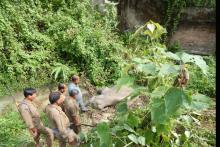Leap-frog in swamp deer population
Despite non stopped rhino poaching Kaziranga has reasons to celebrate. There has been steep rise in swamp deer population in the national park.
Forest minister Etwa Munda told reporters in the world heritage site on Monday that the swamp deer population has gone up by 275. He revealed it a day after the census conducted jointly by forest department, Wildlife Trust of India and ONGC.
Random Stories
26 Jan 2017 - 9:15pm |
Syed Miraz Ahmed
WWF-India AAPSO Thursday launched its much-awaited volunteer programme, WWF Volunteers at Sudmersen Hall, Cotton College aimed at inspiring individuals and organizations to take positive conservation...
9 Sep 2017 - 9:32am |
AT Kokrajhar Bureau
The All Bodo Student's Union(ABSU) has come down heavily on education minister Dr Himanta Biswa Sarma for appointment of non-Bodo medium teachers in Bodo medium schools across the state when the...
7 Jun 2015 - 10:05pm |
AT News
Centre for Conservation Education and Research (CCER) has strongly opposed and condemned the encroachment by the Numaligarh Refinery Limited on the traditional elephant corridor in Deopahar PRF under...
31 Mar 2015 - 12:11pm |
AT News
Dispur on Monday has asked the Darrang Deputy Commissioner to file a detailed report on the incident where nearly a dozen students were taken ill after they were administered JE vaccination on Monday...
Other Contents by Author
Marking a significant milestone for conservation of Amur falcons in the northeast Indian state of Nagaland, three villages in Wokha district have pledged to save the migratory raptor in Doyang Reservoir - its largest roosting site in the country. With mass annual hunt potentially threatening the species, a resolution has been cleared by the villages to penalise offenders, this year onwards.Village Council Members (VCM) of Pangti, Asshaa and Sungro signed a tri-party Memorandum of Understanding with the Wildlife Trust of India (WTI) and the Wokha-based NGO Natural Nagas, to assist the Nagaland Forest Department to stop the wide-scale hunt which was brought to light last year.Tens of...
A sub-adult wild tusker stranded in human-dominated area in Nagaon district of Assam was successfully translocated to the wild. The exhaustive two-day rescue operation was carried out by the Forest Department assisted by IFAW-WTI team, local elephant experts, mahouts and phandies, with local police and paramilitary forces fencing the crowd of thousands.The tusker was separated from its herd, was disoriented and had been taking shelter for over 70 days in and around Kaki Reserve Forest. It had been caught in conflict with people, resulting in damage to property and crops and even casualty of a farmer; it was also treated for gunshot injuries by the authorities assisted by...
A seven-year old male leopard is being shifted today to the Nagaland Zoological Park from the Centre of Wildlife Rehabilitation and Conservation (CWRC), near Kaziranga National Park. The Assam Forest Department and International Fund for Animal Welfare -Wildlife Trust of India (IFAW-WTI) run CWRC had been taking care of the leopard since 2006, after he was found alone in a tea garden by locals and handed over to the authorities. "When we get any animal at CWRC, our first choice is to look into rehabilitation back in the wild. However, rehabilitation is not an easy option for large carnivores, considering the need for extensive space as they are territorial animals, and...
The International Fund for Animal Welfare - Wildlife Trust of India (IFAW-WTI) has provided 35 boats to the Kaziranga National Park authorities to assist in anti-poaching patrolling in the flood-prone UNESCO World Heritage that houses more than 70% of the world's greater one horned rhinoceros.The boats are largely aimed at providing assistance to the local field staff in their patrolling (anti poaching) activities during the floods in Kaziranga National Park. Every year the park faces flooding of the Brahmaputra river, causing many animals to wander out in search of higher grounds. Many that are caught in the floods are rescued and rehabilitated by the Forest...
As preparations to tackle potential flood emergencies are on at the Centre for Wildlife Rehabilitation and Conservation (CWRC), good news poured in for the rehabilitators, as yet another rhino hand-reared here gave birth to a healthy calf in the wild in Manas National Park.The female rhino, named Jamuna, was rescued as a three-month-old calf during the annual floods in the famed Kaziranga National Park in June 2004, by the Assam Forest Department. She was admitted to the Assam Forest Department and IFAW-WTI run CWRC near Kaziranga for hand-raising and rehabilitation. In 2007, she along with another female calf, Ganga, was moved to Manas NP.With this, all three female rhinos...
A rescued rhino calf, Purabi, under care at Centre for Wildlife Rehabilitation and Conservation (CWRC) was moved to Manas National Park today, to join an orphaned rhino calf being hand-reared there. This is being done to increase the rehabilitation prospects of the latter calf which has been deprived of company of its kind since its mother was poached early this year.“We have been rescuing rhino calves at Kaziranga in various circumstances and most of them are now successfully hand raised at CWRC. At due course of time all these calves go back to the wilderness again,” said NK Vasu, Chief Conservator of Forest and Director, Kaziranga National Park.Purabi was separated from her mother...







Add new comment